Today we travel back to Penang, to share with you our experience of Thaipusam, Malaysia’s biggest Hindu festival.
Warning: the following post contains images that some people might find disturbing.
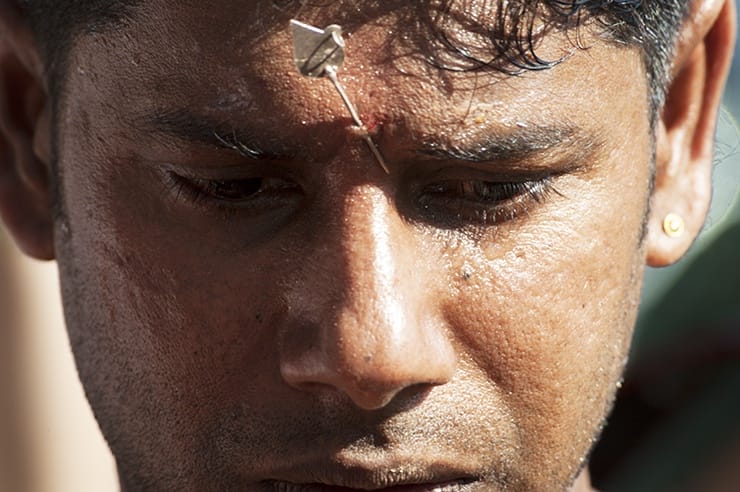
My grandfather lived in Malaysia in the Fifties. Among the mementos of his time in the Far East I remember an old video showing a procession of men with spears through their tongues and cheeks, filmed in Singapore during Thaipusam. I remained captivated for years, and finally decided to go and see for myself. The biggest Thaipusam celebration takes place in Batu Caves near KL; but I decided to go to Penang, where the festival is smaller but no less spectacular. The name Thaipusam derives from the Tamil month of Thai (January-February) and Poosam, referring to a star which reaches its highest position during the festival.
What is Thaipusam?
Thaipusam is dedicated to Lord Murugan, the god of war in the Hindu-Tamil pantheon of deities. During the festival, devotees praise the god by carrying physical burdens called kavadi during a procession to the god’s temple. Although I was warned the festival is rather overwhelming, nothing could prepare me to the sight of kavadi getting ready for the procession.
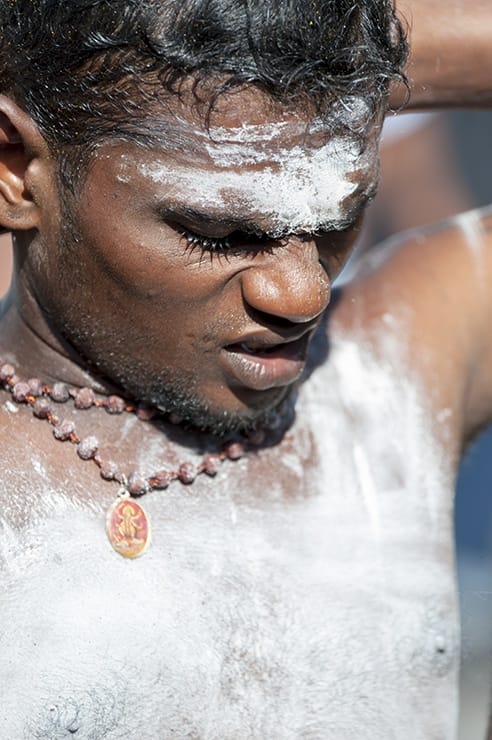
Thaipusam is a show of devotion and endurance unlike any other. I learned kavadi can take various forms, from simple steel pots filled with offerings to effigies of Lord Murugan on scaffolds. Papier-mache images of the god are decorated with flowers or peacock feathers and placed on a wood or steel frame, reaching a weight of around 40kg.
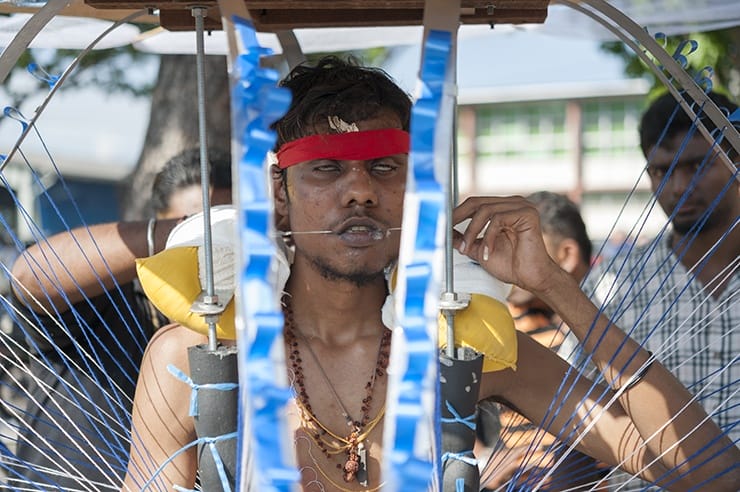
What makes Thaipusam popular amongst locals and tourists alike, though, is the sight of vel or spiked kavadis, devotees that perform flesh mortification inserting spikes through their cheeks or applying hooks in their backs. Some devotees carry all types of kavadi at once, others have their chest and back covered by small pots containing milk hooked on their skin, looking like a makeshift armour.
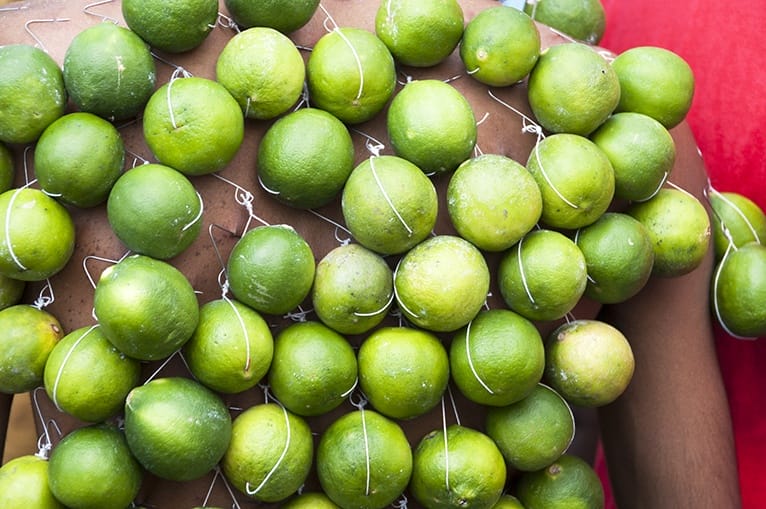
Thaipusam in Penang
In Penang the Thaipusam procession starts at Kovil Veedu (House Temple) in the centre of Georgetown, and terminates at Nattukkottai Chettiar Temple on Waterfall Road, 6km away.
Early in the morning, vel kavadi are applied to the bodies of kavadi bearers. Small groups of family and friends gathered around the devotee, whilst I curiously approached to catch a glimpse. At the centre of one of these circles, I was welcomed by the family of Kumar, a 27-year-old man. Plates with offerings of fruit were laid out, Kumar barely visible through a haze of incense smoke.

A bearded priest with shaved head and chest-long beard chanted verses to Lord Murugan, joined by Kumar’s family. As the pace of the chant and the beat increased, the priest then pushed a spear through Kumar’s cheek. Afterwards, Kumar got up, arranged a milk pot on his head, and started marching.
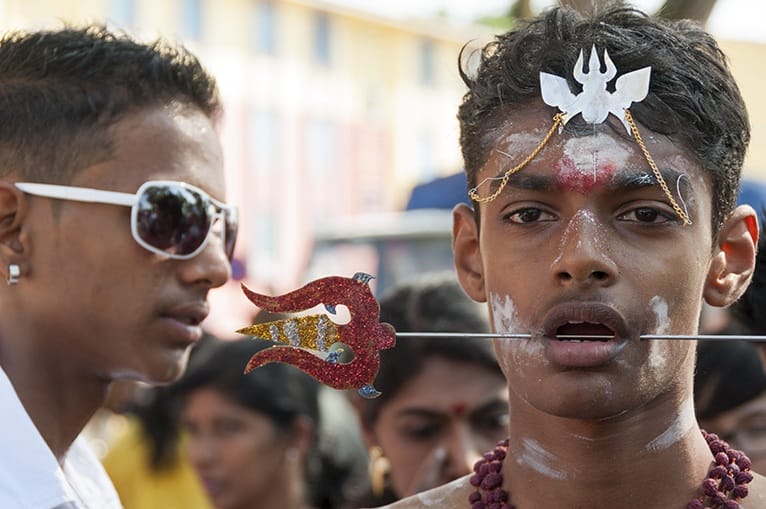
Devotees are in a trance when their bodies are pierced; they didn’t appear to be in pain. Speaking to Jeya, who was supporting her 21 year-old nephew Niru, I learnt why. Kavadi-carriers undertake a severe regime to prepare themselves for the festival, to cleanse themselves in order to gain communion with the god. For 21 days Niru had to abstain from alcohol, smoking, chewing betel nuts and ‘girl thinking’. Kavadi-bearers are required to sleep on the floor, bathe with cold water and fill their time with prayer, meditation and charitable activities. They must also follow a sattvik diet, which allows the consumption of basic, unprocessed vegetarian food. Onion, garlic, red chillies and strong spices are forbidden, whilst dairy products are especially recommended, alongside with fruit.
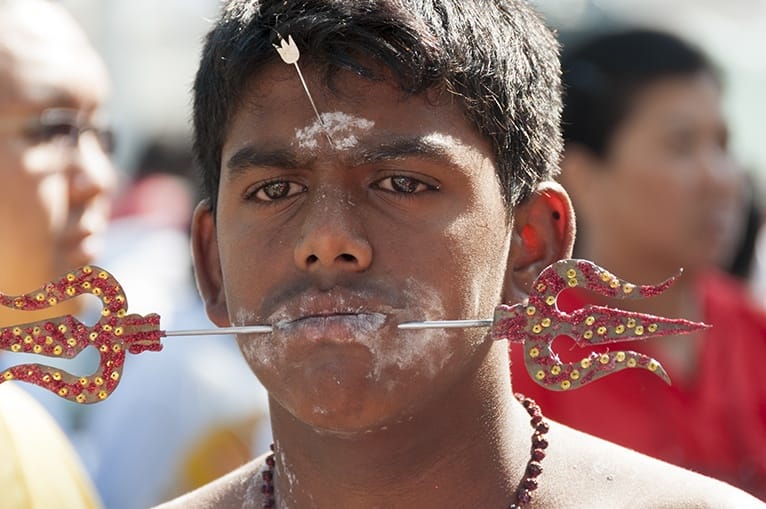
From Jeya, I discovered Niru was indeed in a trance when his cheeks where pierced by a horrendous-looking spear. After practising meditation, on the day the devotee is able to transcend aided by his practice and by the chants and prayers performed around him. Indeed, there was almost no blood coming from their wounds, and Jeya said there will be no scars afterwards.
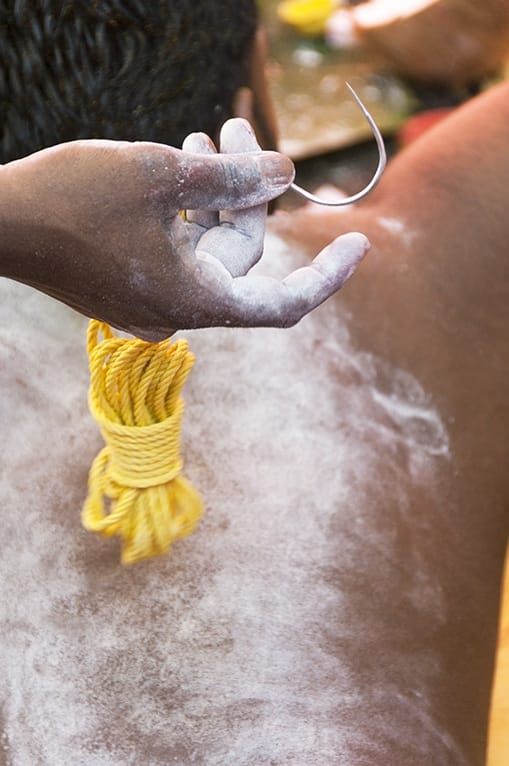
To my untrained, secular Western mind the degree of mortification appeared justifiable only if done to show thanks for a life saved or something along these lines. With an estimated number of around 300 kavadi each year, it seemed to me like an awful lot of lives saved.
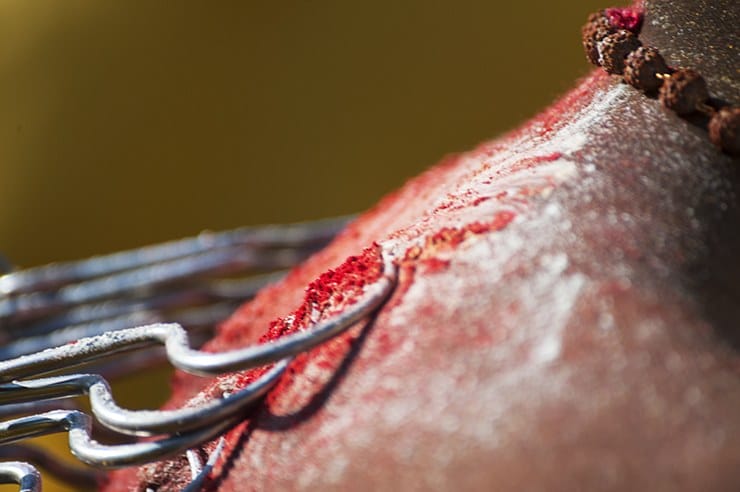
I spoke with the family of a boy in his late teens, who was giving thanks for being admitted to study IT at university. Another young man, whose friends were taking turns in pulling the hooks attached to his back, was participating in the festival to praise Lord Murugan for ‘good business’.
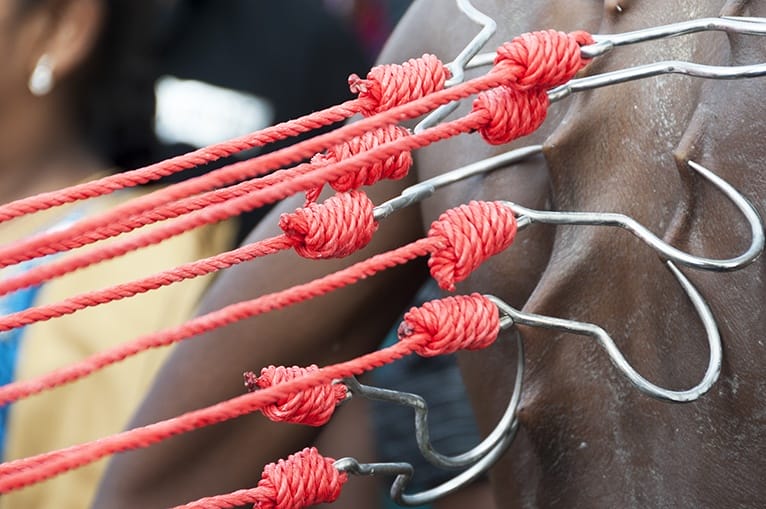
A young lady had her forehead pierced by a small skewer to celebrate the birth of her baby son, after unsuccessfully trying to conceive for a number of years. Although the majority of kavadi were Tamil, thanks to Penang’s melting pot I also saw some Chinese families supporting their very own kavadi-bearer, and even a group of three Westerners. It was nearly impossible to grab a glimpse of the Westerners, who were clearly the attraction of the day. Asking around I found out they were three friends, one of whom had recently survived a difficult kidney transplant.
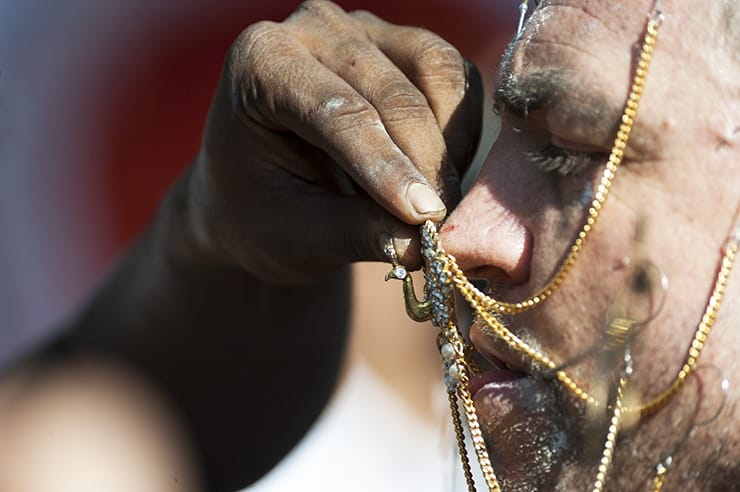
In the afternoon, the magic of Thaipusam was far from over. As the sun came down, we got respite from the heat, and the kaleidoscope of colours was bathed by a magical light. One colour was prevalent among the glitzy saris and the bright images of Lord Murugan; saffron, the colour of holiness. Male kavadi-carriers wore saffron loincloths, women wore simple saffron blouses, while devotees of all ages, men and women, sported a shaved head covered in a saffron-coloured paste.
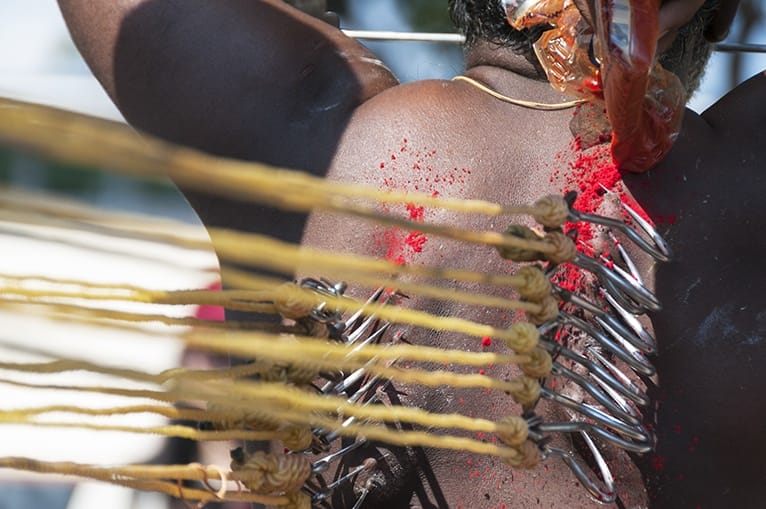
Waterfall Road, the street leading to the temple where the procession was going to end, was lined with garishly coloured foodstalls on both sides, from where devout families served free food. The smell of curries and tea filled the air, upbeat music was playing to accompany kavadi-attam, the ritualistic dance performed by kavadi-bearers. Group of youths played contemporary music on mobile phones to cheer their friends on.
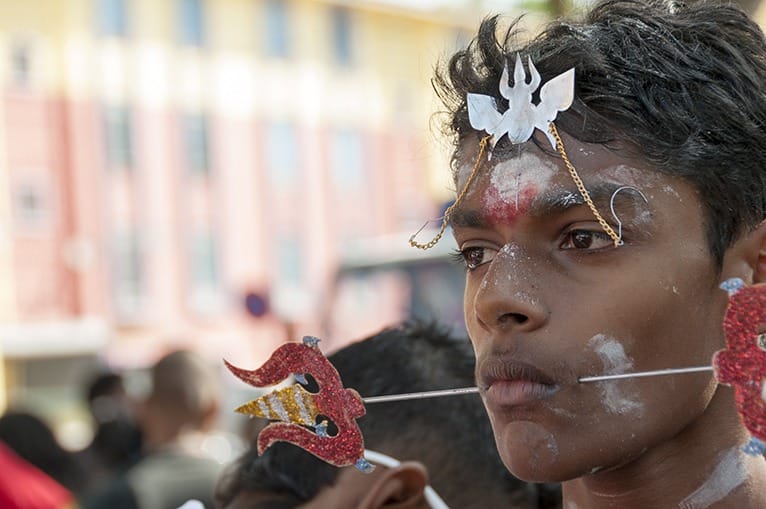
The devotees had been carrying kavadi since morning, under the blazing sun; they appeared exhausted, but none gave up. There were men carrying Lord Murugan’s image on their back spinning frantically at techno beats, others kept walking, unperturbed with a metre-long spear balanced through their cheeks. I couldn’t believe the sight of four young men pulling a tractor by a double row of hooks and ropes through their backs, and nothing else.
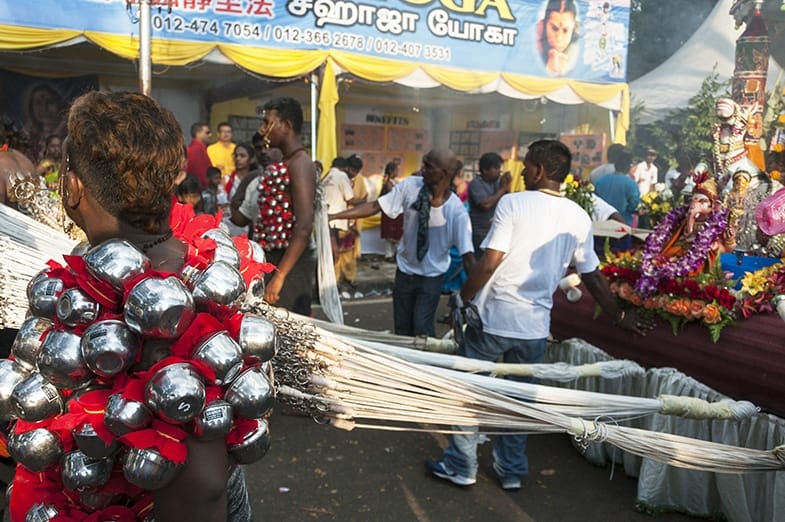
As I got closer to the temple, the crowd increased, until it was very hard to proceed unless I joined one of the small clusters of friends and relatives following a kavadi-bearer. I chose a teenage boy named Krishna, dressed in red and balancing one of the biggest spears of the day through his cheeks. The strain on his face was visible; from his friends I discovered he had been carrying the kavadi for about 8 hours.
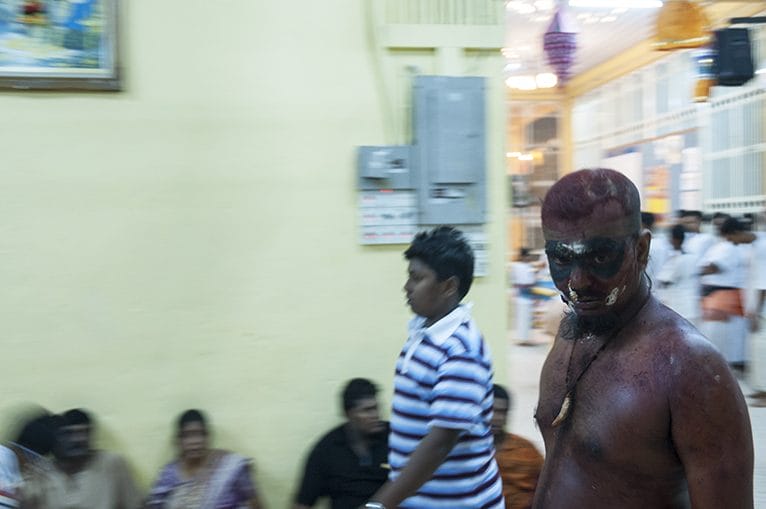
When we approached the temple hill, I believed I detected a glimpse of relief in his eyes. The temple was packed. I battled my way through, curious to see what happened when Krishna reached the main altar. I expected something along the lines of the morning ceremony, with incense, chanting and prayers. I was wrong; spears and hooks were quickly removed, a few handfuls of ash smeared on the wounds, the milk from the pots unceremoniously dumped in a large tank. I wanted to talk to Krishna, but the ordeal of the day had taken its toll on the young man. After the spear was removed and a red kerchief wrapped around his mouth, he fell asleep on the temple steps.
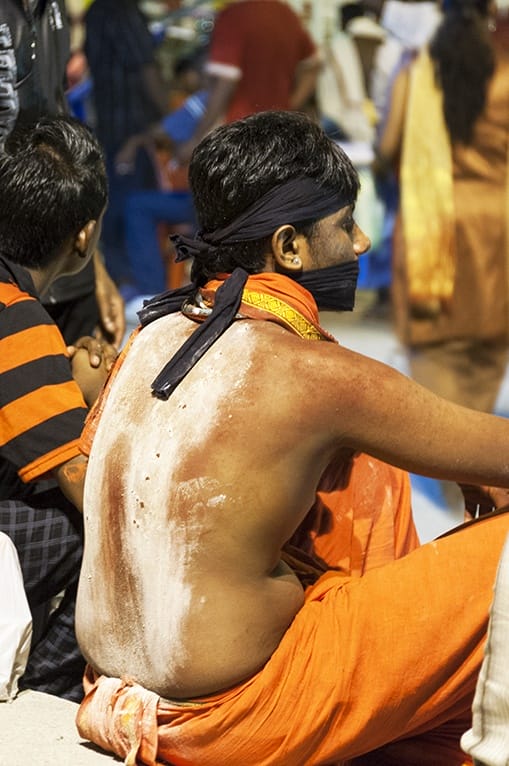

Excellent post, guys. What an interesting customs. And serious devotion. Looks and sounds extremly painful (regardless of the amount of the meditation the devotee goes through prior to it). On a side note: where in Italy are you?
Thanks guys! Glad you loved the shot, and you’re definitely right, I’m sure there was a lot of pain involved. We live in Milan, hope to meet you one day!
I think Thaipusam is one of the most memorable things that I have witnessed in Penang. I like that you took us through the event from beginning to end and that you took the time to find out people’s stories.
Thanks Michele. I am glad you liked the post. It was one of the most unforgettable experiences of my life!
I cringe at the idea of being pierced in those places. The amount of pain these men must tolerate. I enjoyed your post and pictures.
Thanks for stopping by Carmen. I hope I was able to convey with my post and pictures even just a fraction of the emotion I felt being there. It was truly unforgettable.
Great post, your photos really capture the essence of the festival. I can almost feel the pain by looking at the extensive piercings especially the guys with hooks on the back.
Thanks Rachel. It was an unforgettable experience, glad you liked the post!
Wow! What a fascinating festival. Thanks for the amazing insight into this especially as I am not sure I could handle it in person as I couldn’t even look at the photos!
Thanks Sharon. I am sorry you found the pics too intense, glad you liked the post!
Wow, I love this post. The pictures are amazing (though I did cringe at some)! I would love to be able to witness this at some point in life. These festivals are usually during Jan to Feb? Maybe I can catch one since I plan to be in SE Asia during that time!
Hi Anna! yes, Thaipusam is usually late Jan-early Feb. Try and make it, it’s a very intense but unforgettable experience!
OMG – very interesting! Amazing that those hooks in the back don’t tear the flesh and that the bearers don’t seem to feel pain. What a privilege to witness this festival…
Thanks guys. It was amazing indeed. One of my most unforgettable travelling experiences thus far!
This has been such an interesting post and probably one of the most unforgettable post I’ve ever read. Your photos are beautiful and really capture the pain, expressions and experience. I can’t get over how much tolerance and devotion these people have. What a humbling experience to witness.
Thanks for this Mary. Thaipusam was one of our most unforgettable travelling experiences, I am glad the post touched you.
Fascinating and gruesome, but I would also love to go to observe and take some amazing photos.
Thanks for stopping by Noel. It was a very intense experience, I highly recommend it.
Hi Margherita, I have not heard about this tradition before. It looks painful to look at but at the same time I can’t take my eyes off the images. You images are truly powerful; they give courage to witness.
hey Marisol. Glad you found the pictures emotional and intense. I have tried my hardest to convey my emotions through this blog post. It was an unforgettable experience. Thanks for stopping by!
Pheeew…. These photos are amazing but slightly disturbing at the same time, I had hard time deciding whether to take a proper look, or to just keep on going… 🙂 I only heard of this festival very recently, not sure I would be fit for it but it was amazing to experience it through your eyes.
Hey Satu! Sorry the pictures were too graphic. The festival was a very intense experience, hope we managed to convey some of the emotions we felt. It was an unforgettable experience.
I grew up in Malaysia and barely an hour from Batu Caves, but have never witnessed a Thaipusam celebration firsthand. I always imagined it’d be so gory with blood everywhere, only learning later that it’s not like that at all, the devotees feel no pain and other cultures in the world also engage in flesh piercing for worship purposes. I’ll have to make sure that I go check out Thaipusam next year. Thnks for sharing your experience!
Thanks for stopping by Ming. Thaipusam was an unforgettable experience, very intense and emotional. I could not believe they feel no pain, despite being reassured by several people. I am sure it will be amazing for you to visit Thaipusam, as you will probably be able to understand the celebration and the culture behind it a lot better than me. Thanks for stopping by!
That really does look like an unforgettable festival Margherita! While the photos looked disturbing on a first glance, they also seemed quite fascinating when considering that meditation in combination with devotion and endurance allowed these people to participate without pain, blood or scars. That really must have been an unforgettable experience for everyone… 🙂
Hey Dennis! Thaipusam is one of my most unforgettable travel experiences so far. the experience is very intense, but it just add to how special it was. Do visit if you can!
Eeek! I couldn’t make it through this post and gave up half way through. Not my kind of festival to check out, but I respect it for what it represents. Thanks for linking up to the #SundayTraveler!
Sorry about that, I thought it could be a bit hardcore for some people… it was a very intense experience, but a memorable one!
I’m going to this next year – can’t wait! These photos are amazing by the way! Thanks for linking up to the #SundayTraveler 🙂
Oh Ashley, don’t miss visiting the orangutans if you get the chance! Best wishes for your Asia trip
Oh my, I am sooo happy to stumble upon this post having clicked through to read about Novotel in Florence (#SundayTraveler), this caught my eye. I went to Thaipusam in Penang in about 1988. It was one of the most amazing experiences of my life and I’ve never forgotten it, and never will but I have no photos of it. I know I had some great ones but I split with the then boyfriend and he got to keep them all. Thank you for sharing this, it’s been an awful long time since I’ve seen images of it. It really is the most incredible festival of mind over matter. I remember being amazed at the total lack of blood and the hideous amount of weight hanging off the hooks pierced through the men’s back. Awesome stuff!
Hey Phoebe, I am so happy you liked the post, and of having brought back memories. If you would like some of the pictures, just send me an email at thecrowdedplanet@gmail.com and I’ll send some through. Thanks for your comment!
Wow, thank you so much, I’d love that, I’ll contact you through email.
Margherita, I do find these photos fascinating, even though for me, some are really hard to look at. People decorate their bodies in so many fashions around the world…I wouldn’t, because I’m a wimp, but you have to admire those that can.